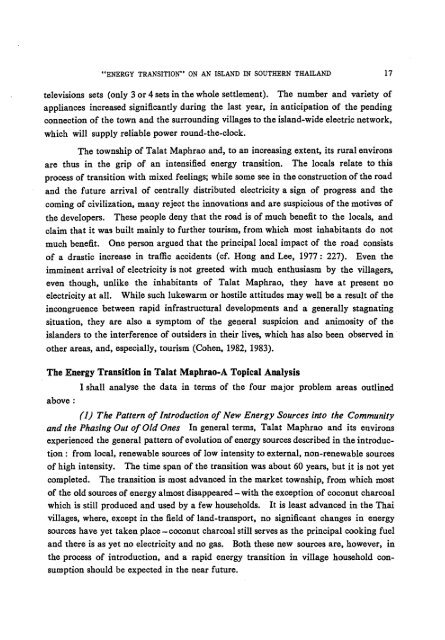The Journal of the Siam Society Vol. LXXI, Part 1-2, 1983 - Khamkoo
The Journal of the Siam Society Vol. LXXI, Part 1-2, 1983 - Khamkoo
The Journal of the Siam Society Vol. LXXI, Part 1-2, 1983 - Khamkoo
You also want an ePaper? Increase the reach of your titles
YUMPU automatically turns print PDFs into web optimized ePapers that Google loves.
"ENERGY TRANSITION" ON AN ISLAND IN SOUTHERN THAILAND 17<br />
televisions sets (only 3 or 4 sets in <strong>the</strong> whole settlement). <strong>The</strong> number and variety <strong>of</strong><br />
appliances increased significantly during <strong>the</strong> last year, in anticipation <strong>of</strong> <strong>the</strong> pending<br />
connection <strong>of</strong> <strong>the</strong> town and <strong>the</strong> surrounding villages to <strong>the</strong> island-wide electric network,<br />
which will supply reliable power round-<strong>the</strong>-clock.<br />
<strong>The</strong> township <strong>of</strong> Talat Maphrao and, to an increasing extent, its rural environs<br />
are thus in <strong>the</strong> grip <strong>of</strong> an intensified energy transition. <strong>The</strong> locals relate to this<br />
process <strong>of</strong> transition with mixed feelings; while some see in <strong>the</strong> construction <strong>of</strong> <strong>the</strong> road<br />
and <strong>the</strong> future arrival <strong>of</strong> centrally distributed electricity a sign <strong>of</strong> progress and <strong>the</strong><br />
coming <strong>of</strong> civilization, many reject <strong>the</strong> innovations and are suspicious <strong>of</strong> <strong>the</strong> motives <strong>of</strong><br />
<strong>the</strong> developers. <strong>The</strong>se people deny that <strong>the</strong> road is <strong>of</strong> much benefit to <strong>the</strong> locals, and<br />
claim that it was built mainly to fur<strong>the</strong>r tourism, from which most inhabitants do not<br />
much benefit. One person argued that <strong>the</strong> principal local impact <strong>of</strong> <strong>the</strong> road consists<br />
<strong>of</strong> a drastic increase in traffic accidents (cf. Hong and Lee, 1977: 227). Even <strong>the</strong><br />
imminent arrival <strong>of</strong> electricity is not greeted with much enthusiasm by <strong>the</strong> villagers,<br />
even though, unlike <strong>the</strong> inhabitants <strong>of</strong> Talat Maphrao, <strong>the</strong>y have at present no<br />
electricity at all. While such lukewarm or hostile attitudes may well be a result <strong>of</strong> <strong>the</strong><br />
incongruence between rapid infrastructural developments and a generally stagnating<br />
situation, <strong>the</strong>y are also a symptom <strong>of</strong> <strong>the</strong> general suspicion and animosity <strong>of</strong> <strong>the</strong><br />
islanders to <strong>the</strong> interference <strong>of</strong> outsiders in <strong>the</strong>ir lives, which has also been observed in·<br />
o<strong>the</strong>r areas, and, especially, tourism (Cohen, 1982, <strong>1983</strong>).<br />
<strong>The</strong> Energy Transition in Talat Maphrao-A Topical Analysis<br />
above:<br />
I shall analyse <strong>the</strong> data in terms <strong>of</strong> <strong>the</strong> four major problem areas outlined<br />
(I) <strong>The</strong> Pattern <strong>of</strong> Introduction <strong>of</strong> New Energy Sources into <strong>the</strong> Community<br />
and <strong>the</strong> Phasing Out <strong>of</strong> Old Ones In general terms, Talat Maphrao and its environs<br />
experienced <strong>the</strong> general pattern <strong>of</strong> evolution <strong>of</strong> energy sources described in <strong>the</strong> introduction<br />
: from local, renewable sources <strong>of</strong> low intensity to external, non-renewable sources<br />
<strong>of</strong> high intensity. <strong>The</strong> time span <strong>of</strong> <strong>the</strong> transition was about 60 years, but it is not yet<br />
completed. <strong>The</strong> transition is most advanced in <strong>the</strong> market township, from which most<br />
<strong>of</strong> <strong>the</strong> old sources <strong>of</strong> energy almost disappeared- with <strong>the</strong> exception <strong>of</strong> coconut charcoal<br />
which is still produced and used by a few households. It is least advanced in <strong>the</strong> Thai<br />
villages, where, except in <strong>the</strong> field <strong>of</strong> land-transport, no significant changes in energy<br />
sources have yet taken place-coconut charcoal still serves as <strong>the</strong> principal cooking fuel<br />
and <strong>the</strong>re is as yet no electricity and no gas. Both <strong>the</strong>se new sources are, however, in<br />
<strong>the</strong> process <strong>of</strong> introduction, and a rapid energy transition in village household consumption<br />
should be expected in <strong>the</strong> near future.

















